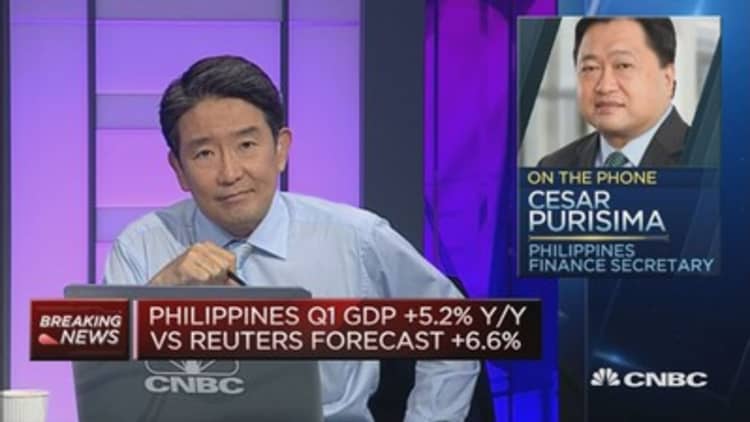
Philippine economic growth suffered a sharp slowdown in the first quarter, a rare miss from its usual solid showing.
The economy grew 5.2 percent in the three months ended March from the year-ago period, data showed on Thursday, compared with the 6.6 percent expansion in the fourth quarter, and missing a Reuters forecast of 6.6 percent.
The expansion, the slowest in three years, was hampered by a dramatic drop in exports, which grew just 1 percent on year compared with 12.8 percent in the fourth-quarter, and as government spending faltered.
Investment remained a bright spot, however, expanding by 10.1 percent on year.
On a quarterly basis, seasonally adjusted growth was 0.3 percent against the fourth quarter's 2.5 percent pace, the slowest quarterly growth in six years.
The stock market slumped on the news, trading down 1.25 percent at mid-day, while the peso reversed earlier gains against the dollar to trade at 44.70.
But analysts broadly took the disappointment in stride, believing the slowdown to be one-off.
"The Philippines economy slowed quite sharply in the first quarter, largely owing to a slowdown in export growth. We do not see cause for too much alarm. Exports are likely to recover later in the year, and domestic demand is still growing at a very healthy rate," Daniel Martin, senior Asia Economist at Capital Economics, wrote in a note.
Southeast Asia's fifth-largest economy has bucked the global trend of monetary policy easing due to solid economic growth, putting it among the fastest-growing major Asian economies. Its improved fiscal position and governance has also led to ratings upgrades, making it a recent standout with investors.
Martin thinks the GDP print is unlikely to trigger measures from the central bank, although it makes the government's 7-8 percent growth forecast for the full year decidedly optimistic.
"The domestic economy is still in good shape. Admittedly our growth forecast of 6.5 percent for the full year now looks on the high side, but at least some rebound from the first quarter is very likely. We still expect rates to kept on hold for the rest of the year," he said.
Read MorePhilippines: Watch out for this roadblock
Barclays also expects no change in monetary policy in the near term, but predicts a hike coming in tandem with any Federal Reserve rate hike, which many analysts expect later this year.
"We expect the BSP (Bangko Sentral ng Pilipinas) [Philippine's central bank] to maintain its neutral to moderately hawkish rhetoric in the coming months, particularly given the looming risk of El Niño for food prices, and continue to forecast a 25 basis point-hike in the fourth quarter following our U.S. economists' projected September liftoff for the Fed," said Barclays analysts said in a note.
Public spending a risk
For ANZ, a key risk for the economy is the continued slump in public spending. With about a year left in office, President Benigno Aquino has been taking steps, including amending tax laws and cracking down on corruption, which has resulted in a drop in public spending.
Economic Planning Secretary Arsenio Balisacan maintained Thursday that an uptick in budget disbursement was not reflected in the first quarter and that he expects it will pick up in the remainder of the year.
"Public spending will need to fire very strongly in coming quarters and there can be no slippage in private consumption at all if growth approaching 7.0 percent full-year is to be achieved," said Glenn Maguire, an economist at ANZ.
"In the absence of public spending picking up," growth could fall to sub-6 percent levels, he added. ANZ has maintained full-year growth for the Philippines at around the "6-handle."

